

Compact Muon Solenoid
LHC, CERN
| CMS-SMP-17-013 ; CERN-EP-2019-074 | ||
| Search for the production of $ \mathrm{ W^{\pm} W^{\pm} W^{\mp} } $ events at $\sqrt{s} = $ 13 TeV | ||
| CMS Collaboration | ||
| 10 May 2019 | ||
| Phys. Rev. D 100 (2019) 012004 | ||
| Abstract: A search for the production of events containing three W bosons predicted by the standard model is reported. The search is based on a data sample of proton-proton collisions at a center-of-mass energy of 13 TeV recorded by the CMS experiment at the CERN LHC and corresponding to a total integrated luminosity of 35.9 fb$^{-1}$. The search is performed in final states with three leptons (electrons or muons), or with two same-charge leptons plus two jets. The observed (expected) significance of the signal for $ \mathrm{ W^{\pm} W^{\pm} W^{\mp} } $ production is 0.60 (1.78) standard deviations, and the ratio of the measured signal yield to that expected from the standard model is 0.34$^{+0.62}_{-0.34}$. Limits are placed on three anomalous quartic gauge couplings and on the production of massive axion-like particles. | ||
| Links: e-print arXiv:1905.04246 [hep-ex] (PDF) ; CDS record ; inSPIRE record ; HepData record ; CADI line (restricted) ; | ||
| Figures & Tables | Summary | Additional Figures | References | CMS Publications |
|---|
| Figures | |

png pdf |
Figure 1:
Tree-level Feynman diagrams for $ \mathrm{ W^{\pm} W^{\pm} W^{\mp} } $ production |
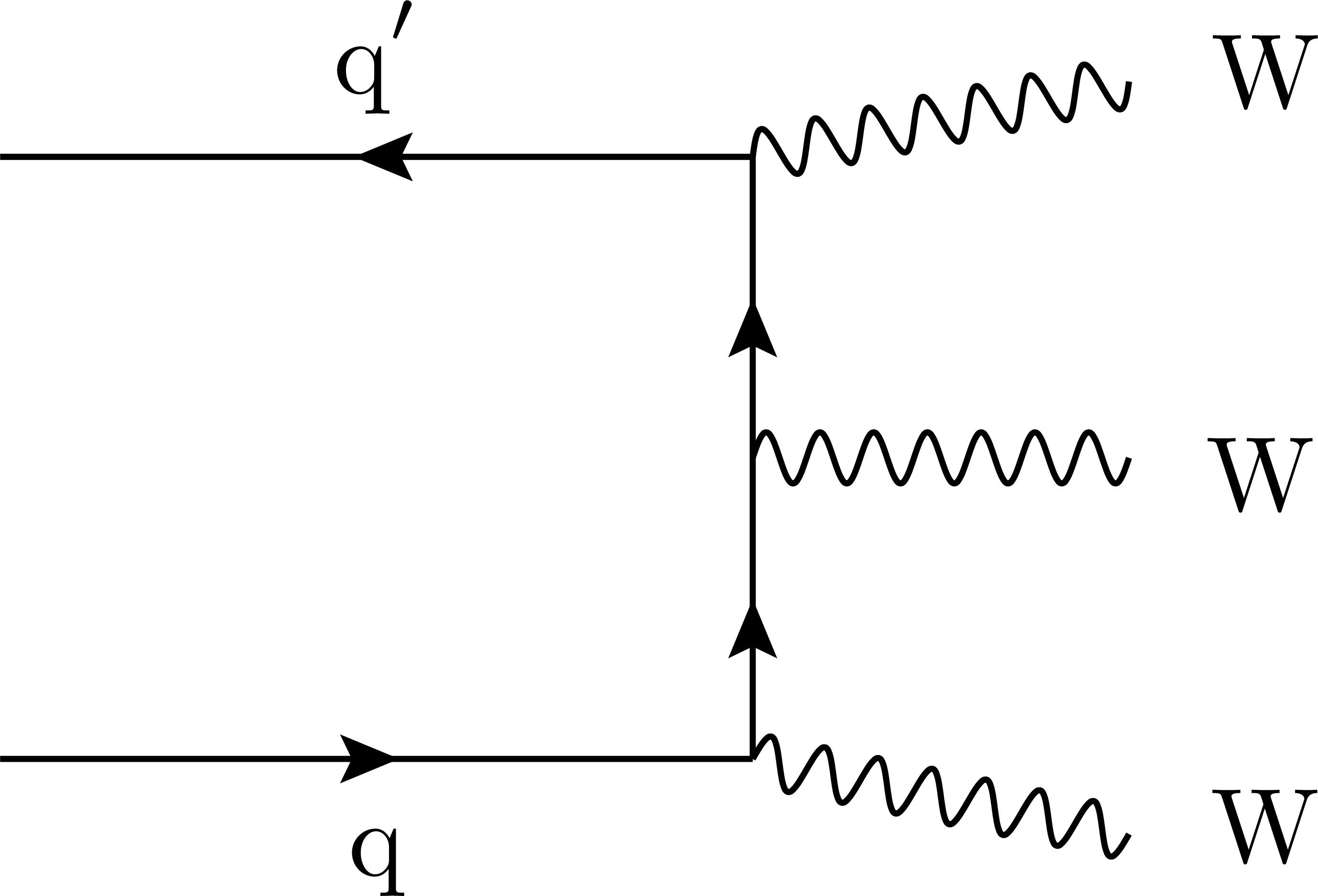
png pdf |
Figure 1-a:
Tree-level Feynman diagram for $ \mathrm{ W^{\pm} W^{\pm} W^{\mp} } $ production |
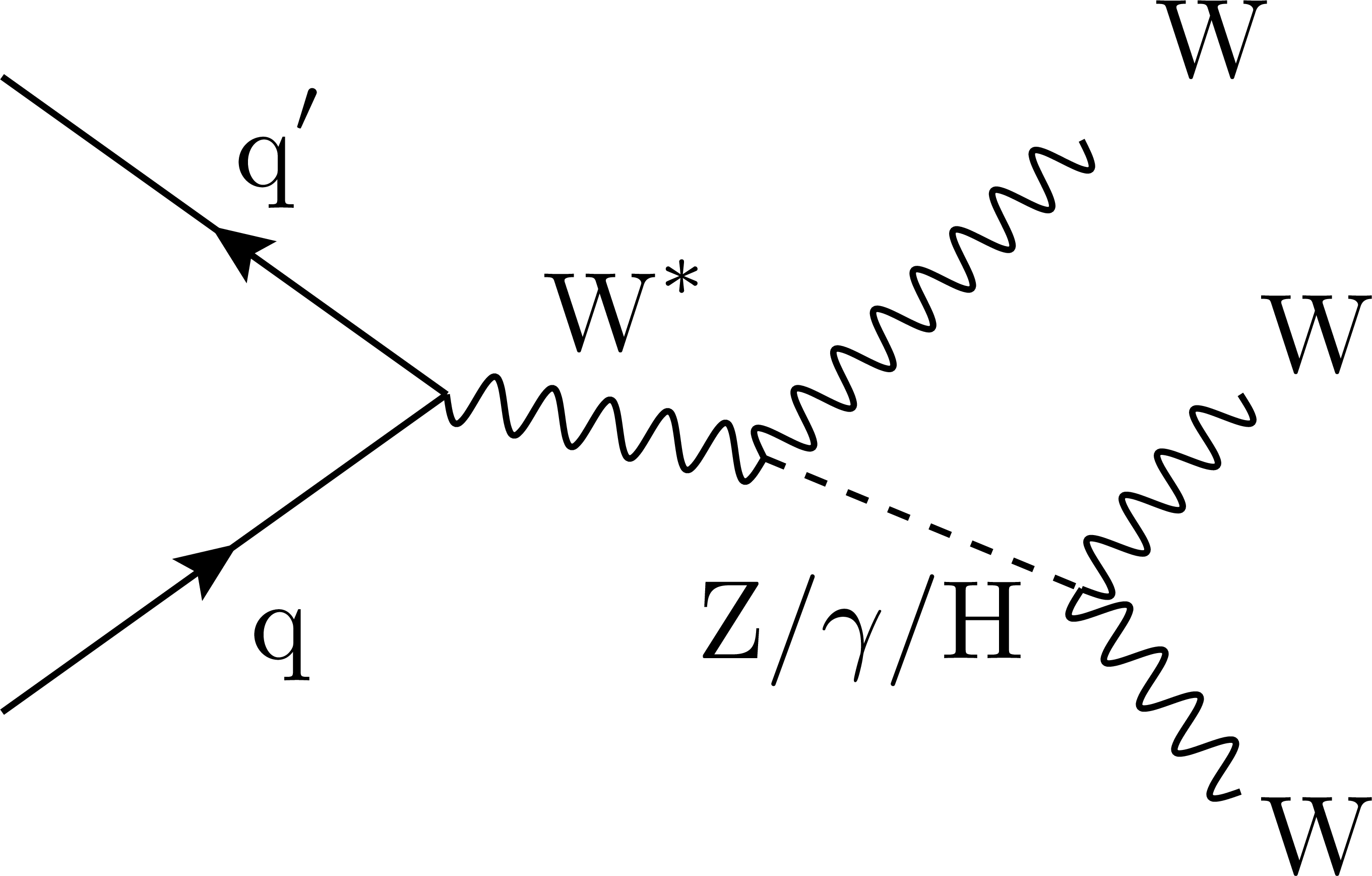
png pdf |
Figure 1-b:
Tree-level Feynman diagram for $ \mathrm{ W^{\pm} W^{\pm} W^{\mp} } $ production |

png pdf |
Figure 1-c:
Tree-level Feynman diagram for $ \mathrm{ W^{\pm} W^{\pm} W^{\mp} } $ production |
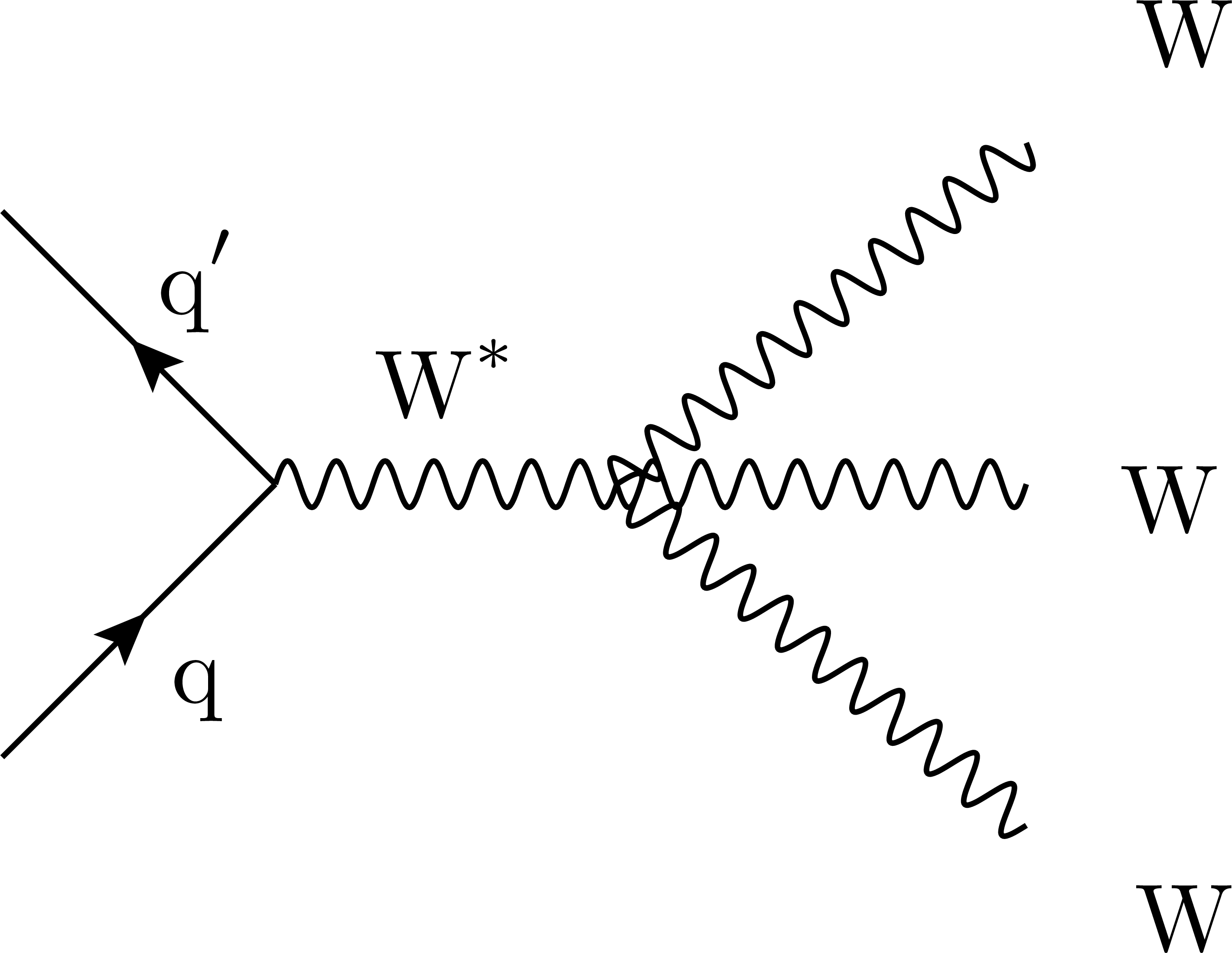
png pdf |
Figure 1-d:
Tree-level Feynman diagram for $ \mathrm{ W^{\pm} W^{\pm} W^{\mp} } $ production |
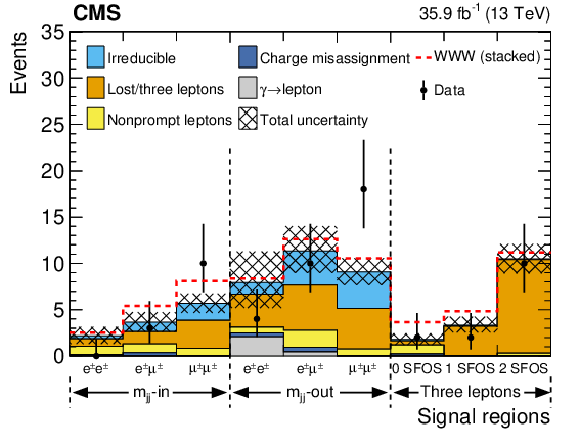
png pdf |
Figure 2:
Comparison of the observed numbers of events to the predicted yields in the nine signal regions. The $ \mathrm{ W^{\pm} W^{\pm} W^{\mp} } $ signal shown is stacked on top of the total background and is based on the SM theoretical cross section. |

png pdf |
Figure 3:
(left) Expected and observed 95% CL upper limits on the product of the cross section and branching fraction $\sigma ({\mathrm{p}} {\mathrm{p}} \to \mathrm{W} {{\mathrm {a}}}) \mathcal {B}({{\mathrm {a}}}\to {\mathrm{W} \mathrm{W}})$ as a function of ALP mass. The red line corresponds to the theoretical prediction for $1/ {f_{{\mathrm {a}}}} = $ 5 TeV$ ^{-1}$. (right) Expected and observed 95% CL upper limits on the photophobic ALP model parameter $1/ {f_{{\mathrm {a}}}} $ as a function of ALP mass. |
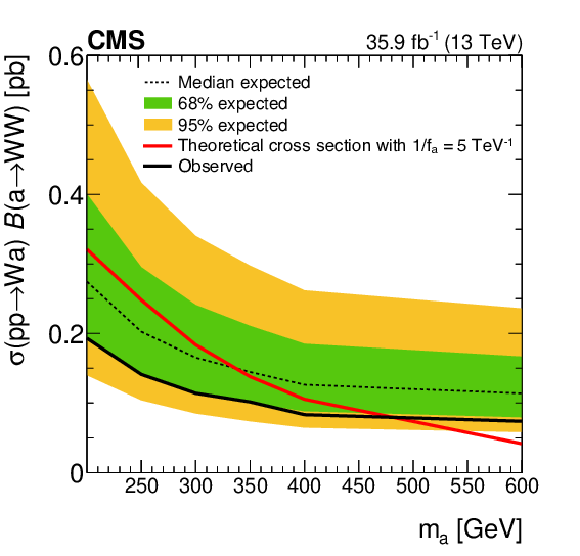
png pdf |
Figure 3-a:
Expected and observed 95% CL upper limits on the product of the cross section and branching fraction $\sigma ({\mathrm{p}} {\mathrm{p}} \to \mathrm{W} {{\mathrm {a}}}) \mathcal {B}({{\mathrm {a}}}\to {\mathrm{W} \mathrm{W}})$ as a function of ALP mass. The red line corresponds to the theoretical prediction for $1/ {f_{{\mathrm {a}}}} = $ 5 TeV$ ^{-1}$. |
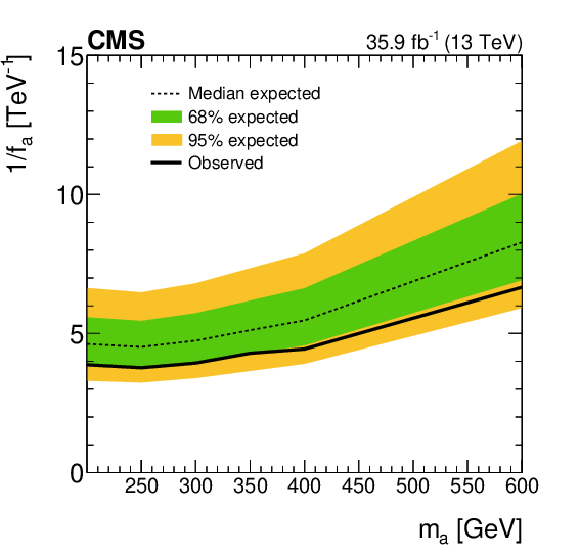
png pdf |
Figure 3-b:
Expected and observed 95% CL upper limits on the photophobic ALP model parameter $1/ {f_{{\mathrm {a}}}} $ as a function of ALP mass. |
| Tables | |
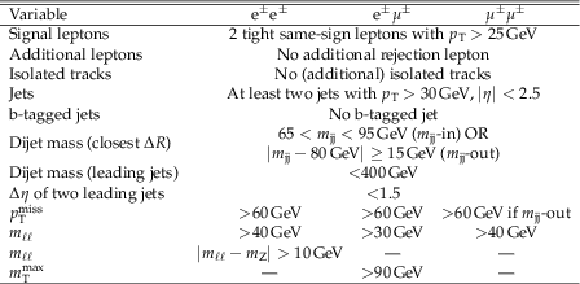
png pdf |
Table 1:
Event selection criteria for the SS category, which contains events with two same-sign leptons and at least two hadronic jets. |
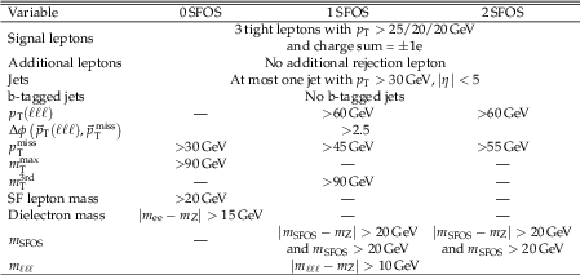
png pdf |
Table 2:
Event selection criteria for the 3$\ell $ category, which contains events with exactly three leptons. |
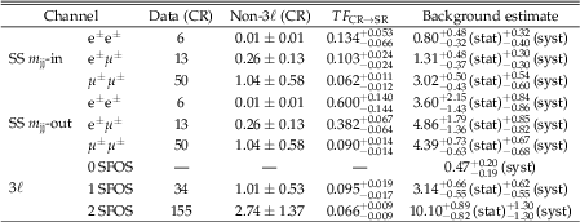
png pdf |
Table 3:
Lost-lepton and three-lepton background contributions. The number of events in the data control regions (CRs) and the non-3$\ell $ contribution, which are estimated from simulation, are reported together with the control-to-signal region transfer factor ($TF_{\mathrm {CR}\to \mathrm {SR}}$). The last column reports the prediction of the lost-lepton and three-lepton background contributions to the signal regions, together with the statistical and systematic uncertainties. |

png pdf |
Table 4:
Nonprompt-lepton background estimates. The data in the application regions (AR), the prompt yields (AR) from simulations, and the predicted nonprompt-lepton background are reported. The uncertainties in the prediction are split into statistical and systematic components. |

png pdf |
Table 5:
Summary of typical systematic uncertainties in estimated background contributions. The ranges indicate variations across different signal regions. |
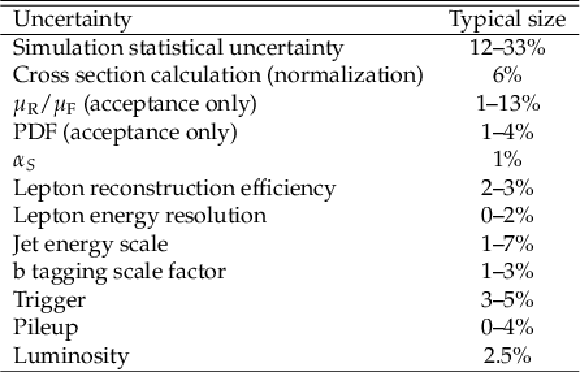
png pdf |
Table 6:
Summary of systematic uncertainties for the signal process. |
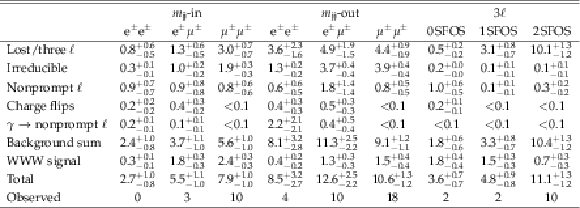
png pdf |
Table 7:
Numbers of observed events for all signal regions, including predicted background contributions and expected signal yields. The uncertainties presented include both the statistical and systematic uncertainties. |

png pdf |
Table 8:
Limits on three anomalous quartic couplings at 95% CL. |
| Summary |
|
A search for $ \mathrm{ W^{\pm} W^{\pm} W^{\mp} } $ production using proton-proton collision data at a center-of-mass energy of 13 TeV was presented. Events with either two same-sign leptons (electrons or muons) and two jets or with three leptons with total charge $\pm$1 were selected. The data were collected with the CMS experiment and correspond to an integrated luminosity of 35.9 fb$^{-1}$. The dominant sources of standard model backgrounds include nonprompt leptons, three-lepton events such as those from the process ${\mathrm{W}\mathrm{Z}} \to3\ell\nu$, as well as ${\mathrm{W^{\pm}}\mathrm{W^{\pm}}}$+jets and ${\mathrm{t\bar{t}}\mathrm{W^{\pm}}}$ production. Predictions for these backgrounds were derived or validated using data in dedicated control regions. The observed (expected) significance for $ \mathrm{ W^{\pm} W^{\pm} W^{\mp} } $ production is 0.60 (1.78) standard deviations and the ratio of measured signal yield to that expected from the standard model is $0.34^{+0.62}_{-0.34}$, which corresponds to a measured cross section of 0.17$^{+0.32}_{-0.17}$ pb. New physics processes that could lead to an excess of events were considered. Limits on anomalous quartic gauge couplings are set, for example; $-1.2 < {f_{\mathrm{T},0}} / \Lambda^4 < $ 1.2 TeV$^{-4}$ at 95% confidence level. Limits are also set on the production of axion-like particles in association with a W boson: mass points between ${m_{{\mathrm{a}} }} = $ 200 and 480 GeV are excluded for the parameter value $1/{f_{{\mathrm{a}} }} = $ 5 TeV$^{-1}$. |
| Additional Figures | |
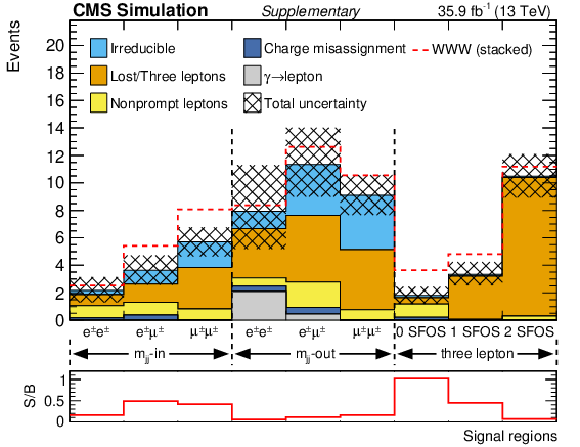
png pdf |
Additional Figure 1:
Predicted signal and background yields normalized to 35.9 fb$^{-1}$ for the nine signal regions. The SM production of WWW events is stacked on top of the background and is based on the SM expectation. The bottom panel shows the relative size of the WWW signal compared to all other SM processes that contribute to the signal regions, labeled here as "S/B''. |

png pdf |
Additional Figure 2:
The top panel shows the comparison of the observed numbers of events to the predicted backgrounds in the nine signal regions. The black dots represent 35.9 fb$^{-1}$ of data collected during 2016 pp collisions. The WWW signal shown is stacked on top of the background and is based on the SM expectation. The bottom panel shows the relative size of the expected WWW signal compared to all other SM processes that contribute to the signal regions, labeled here as "S/B''. In both panels, the signal regions are ordered according to S/B. |

png pdf |
Additional Figure 3:
Data and simulation yields for the lost lepton/3-lepton control regions for 35.9 fb$^{-1}$. The regions are defined from left to right as the control regions for $e^{\pm}e^{\pm}$, $e^{\pm}\mu ^{\pm}$, $\mu ^{\pm}\mu ^{\pm}$, 1 SFOS, and 2 SFOS. The bottom panel shows the ratio of data over simulation. The shaded area represents the statistical uncertainty associated with the background prediction. |
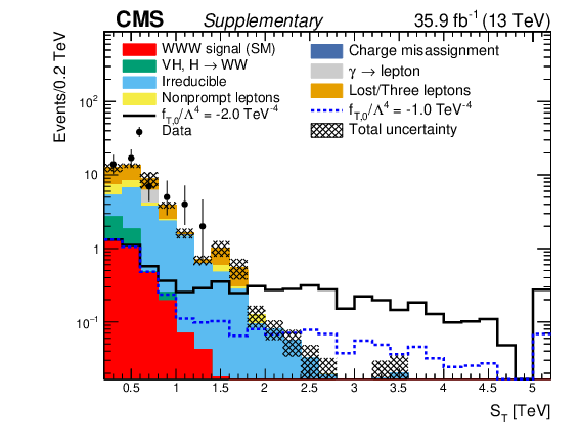
png pdf |
Additional Figure 4:
The distribution of the $S_\mathrm {T}$ variable, defined as the scalar sum of the transverse momenta of all jets, leptons, and ${{p_{\mathrm {T}}} ^\text {miss}}$, in the same-sign dilepton signal region presented on a logarithmic scale. The backgrounds are represented as filled histograms and the the data are represented with black dots. Two anomalous coupling scenarios, corresponding to two different values of ${{\mathrm {f}}_{{\mathrm {T}},0}}/{\Lambda ^{4}}$, are overlaid. The last bin contains the overflow. The shaded area represents the statistical uncertainty associated with the background prediction. |
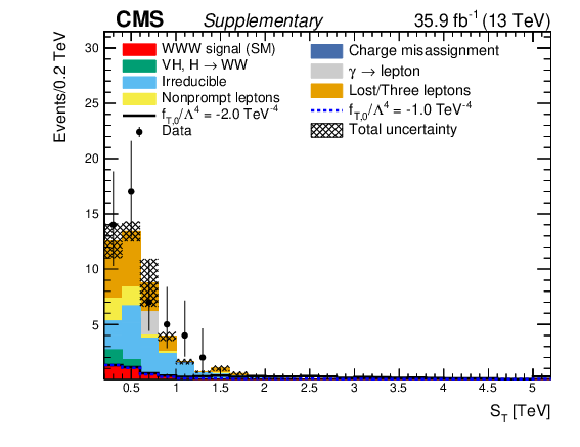
png pdf |
Additional Figure 5:
The distribution of the $S_\mathrm {T}$ variable, defined as the scalar sum of the transverse momenta of all jets, leptons, and ${{p_{\mathrm {T}}} ^\text {miss}}$, in the same-sign dilepton signal region presented on a linear scale. The backgrounds are represented as filled histograms and the the data are represented with black dots. Two anomalous coupling scenarios, corresponding to two different values of ${{\mathrm {f}}_{{\mathrm {T}},0}}/{\Lambda ^{4}}$, are overlaid. The last bin contains the overflow. The shaded area represents the statistical uncertainty associated with the background prediction. |
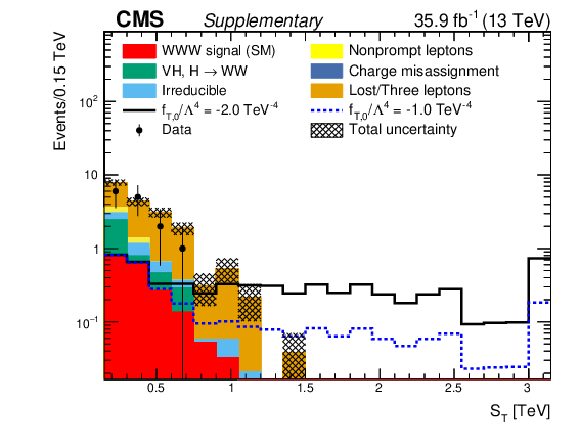
png pdf |
Additional Figure 6:
The distribution of the $S_\mathrm {T}$ variable, defined as the scalar sum of the transverse momenta of all jets, leptons, and ${{p_{\mathrm {T}}} ^\text {miss}}$, in the trilepton signal region presented on a logarithmic scale. The backgrounds are represented as filled histograms and the the data are represented with black dots. Two anomalous coupling scenarios, corresponding to two different values of ${{\mathrm {f}}_{{{\mathrm T},0}}}/{\Lambda ^{4}}$, are overlaid. The last bin contains the overflow. The shaded area represents the statistical uncertainty associated with the background prediction. |

png pdf |
Additional Figure 7:
The distribution of the $S_\mathrm {T}$ variable, defined as the scalar sum of the transverse momenta of all jets, leptons, and ${{p_{\mathrm {T}}} ^\text {miss}}$, in the trilepton signal region presented on a linear scale. The backgrounds are represented as filled histograms and the the data are represented with black dots. Two anomalous coupling scenarios, corresponding to two different values of ${{\mathrm {f}}_{{{\mathrm T},0}}}/{\Lambda ^{4}}$, are overlaid. The last bin contains the overflow. The shaded area represents the statistical uncertainty associated with the background prediction. |
| References | ||||
| 1 | S. Dittmaier, A. Huss, and G. Knippen | Next-to-leading-order QCD and electroweak corrections to WWW production at proton-proton colliders | JHEP 09 (2017) 034 | 1705.03722 |
| 2 | LHC Higgs Cross Section Working Group Collaboration | Handbook of LHC Higgs cross sections: 4. deciphering the nature of the Higgs sector | 1610.07922 | |
| 3 | ATLAS Collaboration | Search for triboson $ {\mathrm{W^{\pm}}\mathrm{W^{\pm}}} $ production in pp collisions at $ \sqrt{s} = $ 8 TeV with the ATLAS detector | EPJC 77 (2017) 141 | 1610.05088 |
| 4 | ATLAS Collaboration | Evidence for the production of three massive vector bosons with the ATLAS detector | Submitted to PLB | 1903.10415 |
| 5 | C. Degrande et al. | Effective field theory: a modern approach to anomalous couplings | Annals Phys. 335 (2013) 21 | 1205.4231 |
| 6 | W. Buchmuller and D. Wyler | Effective Lagrangian analysis of new interactions and flavor conservation | NPB 268 (1986) 621 | |
| 7 | B. Grzadkowski, M. Iskrzyński, M. Misiak, and J. Rosiek | Dimension-six terms in the standard model Lagrangian | JHEP 10 (2010) 085 | 1008.4884 |
| 8 | C. Degrande | A basis of dimension-eight operators for anomalous neutral triple gauge boson interactions | JHEP 02 (2014) 101 | 1308.6323 |
| 9 | CMS Collaboration | Search for anomalous couplings in boosted $ \mathrm{W}\mathrm{W}/\mathrm{W}\mathrm{Z}\to\ell\nu\mathrm{q}\mathrm{\bar{q}} $ production in proton-proton collisions at $ \sqrt{s} = $ 8 TeV | PLB 772 (2017) 21 | CMS-SMP-13-008 1703.06095 |
| 10 | CMS Collaboration | Measurements of the $ {\mathrm{p}}{\mathrm{p}} \to \mathrm{W}\mathrm{Z} $ inclusive and differential production cross section and constraints on charged anomalous triple gauge couplings at $ \sqrt{s} = $ 13 TeV | JHEP 04 (2019) 122 | CMS-SMP-18-002 1901.03428 |
| 11 | CMS Collaboration | Measurement of electroweak production of a W boson in association with two jets in proton-proton collisions at $ \sqrt{s} = $ 13 TeV | Submitted to EPJC | CMS-SMP-17-011 1903.04040 |
| 12 | ATLAS Collaboration | Measurement of the electroweak production of dijets in association with a Z boson and distributions sensitive to vector boson fusion in proton-proton collisions at $ \sqrt{s} = $ 8 TeV using the ATLAS detector | JHEP 04 (2014) 031 | 1401.7610 |
| 13 | ATLAS Collaboration | Measurements of $ \mathrm{W^{\pm}}\mathrm{Z} $ production cross sections in pp collisions at $ \sqrt{s} = $ 8 TeV with the ATLAS detector and limits on anomalous gauge boson self-couplings | PRD 93 (2016) 092004 | 1603.02151 |
| 14 | ATLAS Collaboration | Measurement of $ \mathrm{W}\mathrm{W}/\mathrm{W}\mathrm{Z}\to \ell \nu\mathrm{q}\mathrm{q}^{\prime} $ production with the hadronically decaying boson reconstructed as one or two jets in pp collisions at $ \sqrt{s} = $ 8 TeV with ATLAS, and constraints on anomalous gauge couplings | EPJC 77 (2017) 563 | 1706.01702 |
| 15 | R. D. Peccei and H. R. Quinn | CP conservation in the presence of pseudoparticles | PRL 38 (1977) 1440 | |
| 16 | R. D. Peccei and H. R. Quinn | Constraints imposed by CP conservation in the presence of pseudoparticles | PRD 16 (1977) 1791 | |
| 17 | S. Weinberg | A new light boson? | PRL 40 (1978) 223 | |
| 18 | F. Wilczek | Problem of strong $ P $ and $ T $ invariance in the presence of instantons | PRL 40 (1978) 279 | |
| 19 | P. W. Graham, D. E. Kaplan, and S. Rajendran | Cosmological relaxation of the electroweak scale | PRL 115 (2015) 221801 | 1504.07551 |
| 20 | I. Brivio et al. | ALPs effective field theory and collider signatures | EPJC 77 (2017) 572 | 1701.05379 |
| 21 | E. Izaguirre, T. Lin, and B. Shuve | Searching for axionlike particles in flavor-changing neutral current processes | PRL 118 (2017) 111802 | 1611.09355 |
| 22 | M. Bauer, M. Neubert, and A. Thamm | Collider probes of axion-like particles | JHEP 12 (2017) 044 | 1708.00443 |
| 23 | M. J. Dolan et al. | Revised constraints and Belle II sensitivity for visible and invisible axion-like particles | JHEP 12 (2017) 094 | 1709.00009 |
| 24 | N. Craig, A. Hook, and S. Kasko | The photophobic ALP | JHEP 09 (2018) 028 | 1805.06538 |
| 25 | CMS Collaboration | The CMS trigger system | JINST 12 (2017) P01020 | CMS-TRG-12-001 1609.02366 |
| 26 | CMS Collaboration | The CMS experiment at the CERN LHC | JINST 3 (2008) S08004 | CMS-00-001 |
| 27 | CMS Collaboration | Performance of the CMS missing transverse momentum reconstruction in pp data at $ \sqrt{s} = $ 8 TeV | JINST 10 (2015) P02006 | CMS-JME-13-003 1411.0511 |
| 28 | J. Alwall et al. | The automated computation of tree-level and next-to-leading order differential cross sections, and their matching to parton shower simulations | JHEP 07 (2014) 079 | 1405.0301 |
| 29 | R. Frederix and S. Frixione | Merging meets matching in MC@NLO | JHEP 12 (2012) 061 | 1209.6215 |
| 30 | J. Alwall et al. | Comparative study of various algorithms for the merging of parton showers and matrix elements in hadronic collisions | EPJC 53 (2008) 473 | 0706.2569 |
| 31 | P. Nason | A new method for combining NLO QCD with shower Monte Carlo algorithms | JHEP 11 (2004) 040 | hep-ph/0409146 |
| 32 | S. Frixione, P. Nason, and C. Oleari | Matching NLO QCD computations with parton shower simulations: the POWHEG method | JHEP 11 (2007) 070 | 0709.2092 |
| 33 | S. Alioli, P. Nason, C. Oleari, and E. Re | A general framework for implementing NLO calculations in shower Monte Carlo programs: the POWHEG box | JHEP 06 (2010) 043 | 1002.2581 |
| 34 | E. Re | Single-top Wt-channel production matched with parton showers using the POWHEG method | EPJC 71 (2011) 1547 | 1009.2450 |
| 35 | R. Gavin, Y. Li, F. Petriello, and S. Quackenbush | FEWZ 2.0: A code for hadronic Z production at next-to-next-to-leading order | CPC 182 (2011) 2388 | 1011.3540 |
| 36 | J. M. Campbell, R. K. Ellis, and C. Williams | Vector boson pair production at the LHC | JHEP 07 (2011) 018 | 1105.0020 |
| 37 | M. Czakon and A. Mitov | Top++: A program for the calculation of the top-pair cross-section at hadron colliders | CPC 185 (2014) 2930 | 1112.5675 |
| 38 | R. Gavin, Y. Li, F. Petriello, and S. Quackenbush | W physics at the LHC with FEWZ 2.1 | CPC 184 (2013) 208 | 1201.5896 |
| 39 | J. M. Campbell and R. K. Ellis | $ \mathrm{t\bar{t}}\mathrm{W^{\pm}} $ production and decay at NLO | JHEP 07 (2012) 052 | 1204.5678 |
| 40 | M. V. Garzelli, A. Kardos, C. G. Papadopoulos, and Z. Trocsanyi | $ \mathrm{t\bar{t}}\mathrm{W^{\pm}} $ and $ \mathrm{t\bar{t}}\mathrm{Z} $ hadroproduction at NLO accuracy in QCD with parton shower and hadronization effects | JHEP 11 (2012) 056 | 1208.2665 |
| 41 | F. Cascioli et al. | $ \mathrm{Z}\mathrm{Z} $ production at hadron colliders in NNLO QCD | PLB 735 (2014) 311 | 1405.2219 |
| 42 | M. Grazzini, S. Kallweit, D. Rathlev, and M. Wiesemann | $ \mathrm{W^{\pm}}\mathrm{Z} $ production at hadron colliders in NNLO QCD | PLB 761 (2016) 179 | 1604.08576 |
| 43 | O. Mattelaer | On the maximal use of Monte Carlo samples: re-weighting events at NLO accuracy | EPJC 76 (2016) 674 | 1607.00763 |
| 44 | NNPDF Collaboration | Parton distributions for the LHC run II | JHEP 04 (2015) 040 | 1410.8849 |
| 45 | T. Sjöstrand et al. | An introduction to PYTHIA 8.2 | CPC 191 (2015) 159 | 1410.3012 |
| 46 | CMS Collaboration | Event generator tunes obtained from underlying event and multiparton scattering measurements | EPJC 76 (2016) 155 | CMS-GEN-14-001 1512.00815 |
| 47 | GEANT4 Collaboration | GEANT4--a simulation toolkit | NIMA 506 (2003) 250 | |
| 48 | CMS Collaboration | Particle-flow reconstruction and global event description with the CMS detector | JINST 12 (2017) P10003 | CMS-PRF-14-001 1706.04965 |
| 49 | M. Cacciari, G. P. Salam, and G. Soyez | The anti-$ {k_{\mathrm{T}}} $ jet clustering algorithm | JHEP 04 (2008) 063 | 0802.1189 |
| 50 | M. Cacciari and G. P. Salam | Dispelling the $ N^{3} $ myth for the $ {k_{\mathrm{T}}} $ jet-finder | PLB 641 (2006) 57 | hep-ph/0512210 |
| 51 | M. Cacciari, G. P. Salam, and G. Soyez | FastJet user manual | EPJC 72 (2012) 1896 | 1111.6097 |
| 52 | CMS Collaboration | Performance of electron reconstruction and selection with the CMS detector in proton-proton collisions at $ \sqrt{s} = $ 8 TeV | JINST 10 (2015) P06005 | CMS-EGM-13-001 1502.02701 |
| 53 | CMS Collaboration | Performance of the CMS muon detector and muon reconstruction with proton-proton collisions at $ \sqrt{s} = $ 13 TeV | JINST 13 (2018) P06015 | CMS-MUO-16-001 1804.04528 |
| 54 | M. Cacciari and G. P. Salam | Pileup subtraction using jet areas | PLB 659 (2008) 119 | 0707.1378 |
| 55 | CMS Collaboration | Jet energy scale and resolution in the CMS experiment in pp collisions at 8 TeV | JINST 12 (2017) P02014 | CMS-JME-13-004 1607.03663 |
| 56 | CMS Collaboration | Identification of heavy-flavour jets with the CMS detector in pp collisions at 13 TeV | JINST 13 (2018) P05011 | CMS-BTV-16-002 1712.07158 |
| 57 | CMS Collaboration | Performance of missing transverse momentum reconstruction in proton-proton collisions at $ \sqrt{s} = $ 13 TeV using the CMS detector | Submitted to JINST | CMS-JME-17-001 1903.06078 |
| 58 | CMS Collaboration | First measurement of the cross section for top quark pair production in proton-proton collisions at $ \sqrt{s} = $ 7 TeV | PLB 695 (2011) 424 | CMS-TOP-10-001 1010.5994 |
| 59 | CMS Collaboration | Search for physics beyond the standard model in events with two leptons of same sign, missing transverse momentum, and jets in proton-proton collisions at $ \sqrt{s} = $ 13 TeV | EPJC 77 (2017) 578 | CMS-SUS-16-035 1704.07323 |
| 60 | CMS Collaboration | Measurement of the cross section for top quark pair production in association with a W or Z boson in proton-proton collisions at $ \sqrt{s} = $ 13 TeV | JHEP 08 (2018) 011 | CMS-TOP-17-005 1711.02547 |
| 61 | CMS Collaboration | Observation of electroweak production of same-sign W boson pairs in the two jet and two same-sign lepton final state in proton-proton collisions at $ \sqrt{s} = $ 13 TeV | PRL 120 (2018) 081801 | CMS-SMP-17-004 1709.05822 |
| 62 | CMS Collaboration | Jet energy scale and resolution performances with 13 TeV data | CDS | |
| 63 | CMS Collaboration | CMS luminosity measurements for the 2016 data taking period | CMS-PAS-LUM-17-001 | CMS-PAS-LUM-17-001 |
| 64 | CMS Collaboration | Measurement of the inclusive W and Z production cross sections in pp collisions at $ \sqrt{s} = $ 7 TeV | JHEP 10 (2011) 132 | CMS-EWK-10-005 1107.4789 |
| 65 | S. Catani, D. de Florian, M. Grazzini, and P. Nason | Soft gluon resummation for Higgs boson production at hadron colliders | JHEP 07 (2003) 028 | hep-ph/0306211 |
| 66 | M. Cacciari et al. | The $ \mathrm{t\bar{t}} $ cross section at 1.8 TeV and 1.96 TeV: a study of the systematics due to parton densities and scale dependence | JHEP 04 (2004) 068 | hep-ph/0303085 |
| 67 | A. Kalogeropoulos and J. Alwall | The SysCalc code: A tool to derive theoretical systematic uncertainties | 1801.08401 | |
| 68 | J. Butterworth et al. | PDF4LHC recommendations for LHC run II | JPG 43 (2016) 023001 | 1510.03865 |
| 69 | The ATLAS Collaboration, The CMS Collaboration, The LHC Higgs Combination Group | Procedure for the LHC Higgs boson search combination in Summer 2011 | CMS-NOTE-2011-005 | |
| 70 | T. Junk | Confidence level computation for combining searches with small statistics | NIMA 434 (1999) 435 | hep-ex/9902006 |
| 71 | A. L. Read | Presentation of search results: the CLs technique | JPG 28 (2002) 2693 | |
| 72 | G. Cowan, K. Cranmer, E. Gross, and O. Vitells | Asymptotic formulae for likelihood-based tests of new physics | EPJC 71 (2011) 1554 | 1007.1727 |
| 73 | O. J. P. Eboli, M. C. Gonzalez-Garcia, and J. K. Mizukoshi | $ {\mathrm{p}}{\mathrm{p}}\to\mathrm{jj}\mathrm{e^{\pm}}\mu^{\pm}\mathrm{g}n\mathrm{g}n $ and $ \mathrm{jj}\mathrm{e^{\pm}}\mu^{-}p\mathrm{g}n\mathrm{g}n $ at $ \mathcal{O}(\alpha(em)^6) $ and $ \mathcal{O}(\alpha(em)^4 \alpha(s)^2) $ for the study of the quartic electroweak gauge boson vertex at CERN LHC | PRD 74 (2006) 073005 | hep-ph/0606118 |
| 74 | M. Schonherr | Next-to-leading order electroweak corrections to off-shell WWW production at the LHC | JHEP 07 (2018) 076 | 1806.00307 |
| 75 | ATLAS Collaboration | Observation of a new particle in the search for the standard model Higgs boson with the ATLAS detector at the LHC | PLB 716 (2012) 1 | 1207.7214 |
| 76 | CMS Collaboration | Observation of a new boson at a mass of 125 GeV with the CMS experiment at the LHC | PLB 716 (2012) 30 | CMS-HIG-12-028 1207.7235 |
| 77 | CMS Collaboration | Observation of a new boson with mass near 125 GeV in pp collisions at $ \sqrt{s} = $ 7 and 8 TeV | JHEP 06 (2013) 081 | CMS-HIG-12-036 1303.4571 |
| 78 | D. Azevedo et al. | Models with extended Higgs sectors at future $ \mathrm{e^{+}e^{-}} $ colliders | PRD 99 (2019) 055013 | 1808.00755 |
| 79 | G. C. Branco et al. | Theory and phenomenology of two-Higgs-doublet models | PR 516 (2012) 1 | 1106.0034 |
| 80 | J. Preskill, M. B. Wise, and F. Wilczek | Cosmology of the invisible axion | PLB 120 (1983) 127 | |
| 81 | L. F. Abbott and P. Sikivie | A cosmological bound on the invisible axion | PLB 120 (1983) 133 | |
| 82 | M. Dine and W. Fischler | The not so harmless axion | PLB 120 (1983) 137 | |
| 83 | A. Hook and G. Marques-Tavares | Relaxation from particle production | JHEP 12 (2016) 101 | 1607.01786 |

|
Compact Muon Solenoid LHC, CERN |

|

|

|

|

|

|